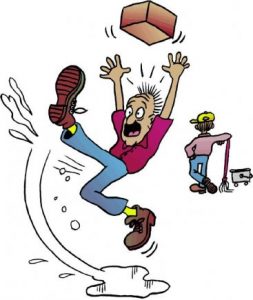Trauma Training Tip
The “flesh” is the tissue associated with the Earth Element in Acupuncture and Asian Medicine.
 While our skin communicates sensations from the outside world, our muscles communicate sensations from our inner experience. If we have an experience of a failure of self-protection – our muscles will hold that story. What we believe and how we feel about that failure will be stored in our muscles. They may be braced or collapsed, or feel weak or invisible. They may experience “unexplainable” pain. They can lose their capacity to control the amount of energy necessary to effect a particular action or movement – lacking the muscular precision necessary for a successful response.
While our skin communicates sensations from the outside world, our muscles communicate sensations from our inner experience. If we have an experience of a failure of self-protection – our muscles will hold that story. What we believe and how we feel about that failure will be stored in our muscles. They may be braced or collapsed, or feel weak or invisible. They may experience “unexplainable” pain. They can lose their capacity to control the amount of energy necessary to effect a particular action or movement – lacking the muscular precision necessary for a successful response.
Muscles can be loud. They tend to have strong opinions and loud voices. The incomplete self-protective responses often take on the form of acute and commanding pain. It can be challenging for this survivor to notice anything other than their pain. It is easy to be distracted by their loud voice and risk missing more important and subtle dynamics in other systems. It is important to help your client experience other messages from their body than their pain – and for clinicians to not get overly distracted by the muscles’ demand for relief and look comprehensively and deeply into their client’s life experience.
Alaine’s Two Cents
The intersection between trauma and race is a critical one for our nation and our world.
 I am grateful to be supporting the efforts of the Somatic Experiencing Trauma Institute (SETI) with recruiting practitioners of color for a SE Professional Training scheduled to begin February 14-17, 2020 at Crossings Healing & Wellness, in Silver Spring, MD. Efforts are being consciously made to remove barriers to attendance due to financial hardship and to support diversity and accessibility for people of color. If you are a person of color, or know a person of color who may benefit from this 3-year training, and can use these important skills in your community, please contact SETI’s director, Marv Tuttle at mtuttle@traumahealing.org for more information. A link for donations to the scholarship fund to support this effort will be available in the near future.
I am grateful to be supporting the efforts of the Somatic Experiencing Trauma Institute (SETI) with recruiting practitioners of color for a SE Professional Training scheduled to begin February 14-17, 2020 at Crossings Healing & Wellness, in Silver Spring, MD. Efforts are being consciously made to remove barriers to attendance due to financial hardship and to support diversity and accessibility for people of color. If you are a person of color, or know a person of color who may benefit from this 3-year training, and can use these important skills in your community, please contact SETI’s director, Marv Tuttle at mtuttle@traumahealing.org for more information. A link for donations to the scholarship fund to support this effort will be available in the near future.
Faculty member Berns Galloway (bernsgalloway@gmail.com) is recruiting Somatic Experiencing Assistants to work with him during this training. This is an opportunity for any practitioners and assistants of color in the DC, Baltimore, surrounding areas, and beyond to participate in this intentional, culturally sensitive SE training.
Check This Out!
The Somatic Experiencing Trauma Institute (SETI) has been hosting me in a seasonal series of webinars.
Here is the most recent one – on the Earth Element. Listen for how the season may be speaking to you!
You will need to download a free copy of Adobe Connect to listen to it.
Clinical Queries & Practice
Where is your clinical curiosity carrying you?
Send me a question or two and I will explore them with readers in this corner next month.
Q. My patient has fibromyalgia. She’s in a lot of pain a lot of the time. Her pain is consuming. She seems to have a lot of other things going on – she appears quite anxious and jumpy – and doesn’t sleep well – but all she talks about is her pain.
A. Great question! Pain can be consuming. It’s meant to communicate information for our safety – better to feel the pain of a broken limb so you won’t attempt to walk on it and do more damage. In fact, people who experienced a lot of pain as a young infant may have needed to essentially “turn off” their capacity to feel pain – their pain was overwhelming and the only way to manage it was to “freeze” in relationship to it. This lack of ability to feel pain as an adult will affect how they navigate the world – they may get injured and exacerbate their injury by not resting and properly caring for themselves.
 With your patient, the opposite has happened – she is only aware of her pain. She has significant dysregulation – as evidenced by her insomnia and anxious, jumpy presentation. You will need to help her find and experience even the smallest experience of comfort to help her “tick-tock” between sympathetic arousal and parasympathetic restoration. Use questions like “what makes your pain feel better?” or “look for your points of contact with the table – look for support or grounding, comfort or trust – what happens in the rest of you?” If she was not able to find comfort with the table, you could ask her “Tell me about a time when you felt less (or no) pain – where were you and what were you doing?”
With your patient, the opposite has happened – she is only aware of her pain. She has significant dysregulation – as evidenced by her insomnia and anxious, jumpy presentation. You will need to help her find and experience even the smallest experience of comfort to help her “tick-tock” between sympathetic arousal and parasympathetic restoration. Use questions like “what makes your pain feel better?” or “look for your points of contact with the table – look for support or grounding, comfort or trust – what happens in the rest of you?” If she was not able to find comfort with the table, you could ask her “Tell me about a time when you felt less (or no) pain – where were you and what were you doing?”
You may also be able to use the kidney/adrenal hold to support some parasympathetic restoration and a “tick-tock” experience to counter her pain. Help her explore this experience of comfort and find a body memory of it. When her attention gets called back to her pain, invite her to “go to the outside edge” of her pain – let her go there briefly and then direct her to come back to this body-experience of comfort that you have helped her create. Go back-and-forth between these two states, watch for more regulation and more coherence to develop.
This “tick-tock” between her pain and some comfort will help create a wave of movement that can unlock the dysregulation that’s creating the pain. This movement of qi may also help her access the “story” that her muscles are carrying, providing an opportunity for her to understand its history and meaning, digest the gristle and harvest some life lessons.
Glad she has you!

